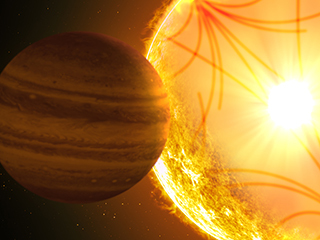NASA’s Kepler space telescope, launched March 6, 2009, was developed to search for planets around other stars and quantify their abundance in our galaxy. But over more than nine years of operations, through the initial four-year "prime" and subsequent K2 missions, Kepler contributed to many other areas of astronomicalresearch.
Kepler operated like a giant light bucket, collecting photons from stars, galaxies and other celestial objects. Its field of view was approximately 11 degrees across, roughly the size on the sky blocked out by an outstretched hand. By acquiring repeated images of a given field, astronomers use the space telescope’s data to precisely measure changes in brightness on timescales from minutes to months and longer. The results, called “light curves,” show different patterns according to the type of object being observed.
Spinning objects — whether stars or asteroids — tend to change brightness in a periodic manner as they rotate. This also provides information about surface features. Binary star systems are another source of periodic variability. In cases where a star's orbit is highly elliptical, its surface is stretched by the companion star's gravity. The stretching not only causes stellar tidal distortions, but can also cause oscillations in the stars. These effects combine to generate light variations resembling the blips on an electrocardiogram – leading to the moniker "heartbeat stars."
In eclipsing binary systems, regular dips in the light curves occur when one star passes in front of the other, blocking some of the latter's light. Likewise, this happens with transiting planets, but the amount of light that is blocked is even smaller. Once detected, eclipses or transits yield information on the size of the stellar or planetary companion as well as its orbital period.
Pulsating stars are another source of regular variation among stars. Sound waves propagating in their interiors cause the surface to oscillate as a gong would when hit with a mallet. The frequencies of the oscillations are set by the properties of the stellar interior. They can be used to derive the age of a star and even whether it is burning hydrogen or helium deep in its core. The process of learning about stars from their oscillations is called asteroseismology – an area of research to which Kepler has contributed greatly.
Not all celestial objects display periodic variability. Some Kepler targets, such as young stars or the nuclei of distant galaxies, accrete gas in a random manner that gives rise to chaotic brightness variations. Other stars appear to vary when dust or rocks encircle them, blocking some of the starlight. Such appears to be the case with Boyajian's star, an object that has displayed mysterious dimming events over many years. Dust also occults the youngest stars, which are encircled by disks of remnant material from their formation. Old stars such as white dwarfs may also be orbited by asteroidal material that causes dimming events in their light curves.
Supernovae are another – albeit rare – source of light variations seen by Kepler. In its observations of tens of thousands of galaxies the space telescope recorded more than a dozen sudden brightening events signifying the explosion of a star. Kepler provided our first glimpses of the first few hours of supernova explosions, data that are now helping to constrain the end states of stars' lives.
Despite ceasing observations on Oct. 30, 2018, Kepler will continue to impact the astronomical community with its high precision brightness monitoring data of many types of astronomical objects, from stars with planets to distant galaxies. Undoubtedly, more discoveries await. All images and light curves from Kepler have been made publicly available and are expected to serve the worldwide astronomical community for years to come.
The Universe Through Kepler's Eyes
In over nine years of observation, NASA's Kepler space telescope imaged hundreds of thousands of stars, many of which host exoplanets. Those planets whose plane of orbit crosses our line of sight to the host star are seen to eclipse, or "transit" and can be detected by Kepler. Indeed, the telescope has enabled astronomers to detect thousands of planets through this transit method.
The discoveries range from Earth-sized rocky bodies to intermediate-sized "super-Earths" and "mini-Neptunes" to gaseous planets the size of Jupiter. These exoplanets orbit a variety of host stars, from small, red dwarfs to Sun-like stars and hotter. The closer the planet to its parent star, the more stellar radiation it receives. Some planets complete their orbit in as few as a few days; these bodies have very high surface temperatures and are known colloquially as "hot roasters." Rocky planet Kepler-10b, for example, is a scorching rocky planet that orbits much closer to its host star than the Mercury-Sun distance. In contrast, the Earth-sized planet Kepler-186f orbits its red dwarf host at a more comfortable distance where conditions may be amenable to liquid water.
Data from Kepler led to the discovery of multiplanet systems. Such is the case with Kepler-90, a Sun-like star orbited by eight bodies including two gas giants and several super-Earths or mini-Neptunes. Other remarkable discoveries include planets in open star clusters and young associations. Of note, the roughly Neptune-sized body K2-33b made news as the youngest confirmed transiting exoplanet (it orbits a newborn star at 5 to 10 million years of age – very young in astronomical terms).











